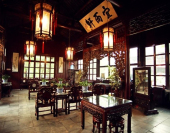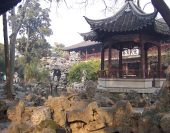
Geyuan Garden Guide
-Travel to Geyuan Garden Located in the eastern part of Yangzhou City, Geyuan Garden is adjacent to Dong-guan Street, an old lane, in the south; and faces East Yanfu Road, an inland river scenic belt, in the north. In 1818, or the 23rd year of the Jiaqing reign of the Qing Dynasty, it was the residence of Salt Distribution Commissioner Huang Zhiyun. Now Geyuan Garden is one of the well-known classical gardens in Yangzhou, and a representative of private gardens of the Ming and Qing dynasties in Yangzhou due to its unique design of scenic spots and lasting artistic charm.
Located in the eastern part of Yangzhou City, Geyuan Garden is adjacent to Dong-guan Street, an old lane, in the south; and faces East Yanfu Road, an inland river scenic belt, in the north. In 1818, or the 23rd year of the Jiaqing reign of the Qing Dynasty, it was the residence of Salt Distribution Commissioner Huang Zhiyun. Now Geyuan Garden is one of the well-known classical gardens in Yangzhou, and a representative of private gardens of the Ming and Qing dynasties in Yangzhou due to its unique design of scenic spots and lasting artistic charm.
 When the bright moon scatters tender light in the Geyuan Garden, those bamboos will throw their and tranquil and elegant shadows on the ground, and look, what can you see? Yes, the shadow of the bamboo leaves resembles the Chinese character “ge”, and this is why this garden is called “Geyuan Garden”. In numerous gardens of Yangzhou, most of which were built in Qing Dynasty, Geyuan Garden is the best-preserved and most valuable one with longest history. The garden is not large, but it has exquisite and delicate arrangements. Walking in the tranquil garden, you will be soon attracted by its artificial landscape. The garden is especially prestigious with its rockworks and bamboos. Strictly constructed and creatively designed, the Geyuan Garden is unique in China and one of the most famous gardens of Yangzhou.
When the bright moon scatters tender light in the Geyuan Garden, those bamboos will throw their and tranquil and elegant shadows on the ground, and look, what can you see? Yes, the shadow of the bamboo leaves resembles the Chinese character “ge”, and this is why this garden is called “Geyuan Garden”. In numerous gardens of Yangzhou, most of which were built in Qing Dynasty, Geyuan Garden is the best-preserved and most valuable one with longest history. The garden is not large, but it has exquisite and delicate arrangements. Walking in the tranquil garden, you will be soon attracted by its artificial landscape. The garden is especially prestigious with its rockworks and bamboos. Strictly constructed and creatively designed, the Geyuan Garden is unique in China and one of the most famous gardens of Yangzhou.
 The garden was first built in the Ming Dynasty. During the Jiaqing reign (1796-1820) and Daoguang reign (1821-1850) of the Qing Dynasty, Salt Distribution Commissioner Huang Zhiyun rebuilt the garden on its old site. Su Dongpo, a famous man of letters of the Song Dynasty, once said: "I would rather have meals without meat than live in a place without bamboo". Half of the Chinese character "?" (bamboo) pronounces "Ge", hence the name Geyuan Garden. The artificial hill, beautified with chambers, pavilions and kiosks, occupies two thirds of the garden's space. Rocks of different hues and shapes are employed to represent scenes of four seasons, hence the name Artificial Hill of Four Seasons. A stroll through this rockwork evokes the impression that one is traveling through all four seasons of the year. The construction style of Geyuan Garden is redolent in the conceptions of the northern and southern schools of traditional Chinese painting. The garden is a nice place for an outing in spring and a feast for the eyes in summer; to invite visitors for a climb in autumn; and looks like a suitable dwelling in winter. No other garden in Yangzhou matches Geyuan Garden in distinct local flavor.
The garden was first built in the Ming Dynasty. During the Jiaqing reign (1796-1820) and Daoguang reign (1821-1850) of the Qing Dynasty, Salt Distribution Commissioner Huang Zhiyun rebuilt the garden on its old site. Su Dongpo, a famous man of letters of the Song Dynasty, once said: "I would rather have meals without meat than live in a place without bamboo". Half of the Chinese character "?" (bamboo) pronounces "Ge", hence the name Geyuan Garden. The artificial hill, beautified with chambers, pavilions and kiosks, occupies two thirds of the garden's space. Rocks of different hues and shapes are employed to represent scenes of four seasons, hence the name Artificial Hill of Four Seasons. A stroll through this rockwork evokes the impression that one is traveling through all four seasons of the year. The construction style of Geyuan Garden is redolent in the conceptions of the northern and southern schools of traditional Chinese painting. The garden is a nice place for an outing in spring and a feast for the eyes in summer; to invite visitors for a climb in autumn; and looks like a suitable dwelling in winter. No other garden in Yangzhou matches Geyuan Garden in distinct local flavor.
More Attractions in Yangzhou
Your Question & Quick Answer*We welcome and appreciate your questions & reviews
Booking Procedures | Terms & Conditions | Payment Methods | Links | Site Map | About Us | Contact Us | Travel Agent
Copyright 2008, All rights reserved.. itourbeijing.com professional china travel guide and china travel service
TEL: 86-10-85711972 (Universal) 1-888-288-9328 (North America) E-mail: contact@itourbeijng.com
Tours Index | China Tours | Beijing Tours | Xi'an Tours | Shanghai Tours | Guilin Tours | Tibet Tours
China Travel | Beijing Travel | Shanghai Travel | Xi'an Travel | Guilin Travel |Beijing Map
China Golf | Beijing Golf | Shanghai Golf | Xiamen Golf | The Great Wall Travel | Yangtze Cruise | Travel Picture



